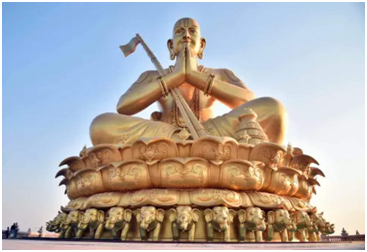PM unveils statue of equality in Hyderabad.
What is the news:
- The Prime Minister, Shri Narendra Modi dedicated to the nation the ‘Statue of Equality’ in Hyderabad today.
- The 216-feet tall Statue of Equality commemorates the 11th century Bhakti Saint Sri Ramanujacharya, who promoted the idea of equality in all aspects of living including faith, caste and creed.
- Governor Telangana Smt Tamilisai Soundararajan, Union Minister Shri G. Kishan Reddy were among those present on the occasion.
- The inauguration of the Statue of Equality is a part of the 12-day Sri Ramanuja Sahasrabdi Samaroham, the ongoing 1000th birth anniversary celebrations of Sri Ramanujacharya.
What Prime Minister Said:
- Speaking on the occasion the Prime Minister greeted everyone on the auspicious occasion of Basant Panchami and expressed happiness on dedication of the statue on such a pious occasion.
- He said “India is giving concrete shape to India’s human energy and inspirations through this grand statue of Jagadguru Sri Ramanujacharya.
- This statue of Sri Ramanujacharya is a symbol of his wisdom, detachment and ideals.”
- The Prime Minister participated in the ‘Purnahuti’ of ‘Vishwaksena Ishti Yagya’. The Yagya is for fulfilment of resolutions and goals.

- The Prime Minister offered the ‘sankalpa’ of the Yagya for the ‘Amrit’ Sankalp of the country and dedicated the yagya to 130 crore countrymen.
- The Prime Minister recalled the Indian tradition of its scholars that views knowledge above rebuttal and acceptance-rejection.
- “If we have ‘advait’ then we have ‘dvait’ too and we also have Sri Ramanujacharya’s ‘Vishishtadvaita’ that encompasses both ‘davit-advait’”, said the Prime Minister.
- He noted that along with the pinnacle of gyan in Sri Ramanujacharya, he is the founder of Bhakti Marg too. One the one hand he is a saint of rich ‘Sanyaas’ tradition, he presents the importance of action in Gita Bhashya, on the other.
- The Prime Minister continued “In today’s world, when it comes to social reforms, progressivism, it is believed that reforms will take place away from the roots. But, when we see Ramanujacharya ji, we realize that there is no conflict between progressiveness and antiquity.
- It is not necessary to go far from your roots for reforms. Rather it is necessary that we connect with our real roots, become aware of our real power.”
About the statue:
- The statue shows the saint in a seated position in padmasana with hands folded.
- The Statue is made of ‘panchaloha’, a combination of five metals: gold, silver, copper, brass, and zync and is among one of the tallest metallic statues in sitting position, in the world.
- It is mounted on a 54-ft high base building, named ‘Bhadra Vedi’, has floors devoted for a Vedic digital library and research centre, ancient Indian texts, a theatre, an educational gallery detailing many works of Sri Ramanujacharya.
- The statue has been conceptualised by Sri Chinna Jeeyar Swami of Sri Ramanujacharya Ashram.
Important :
- Referring to Hyderabad connection of Sardar Patel, the Prime Minister said “if Sardar Sahib’s ‘Statue of Unity’ is repeating the oath of unity in the country, then Ramanujacharya’s ‘Statue of Equality’ is giving the message of equality. This is the specialty of India as a nation.”
- The Prime Minister elaborated on the richness of the Telugu culture and how it has enriched India’s diversity.
- He recalled the long traditions of kings and queen who were torchbearers of this rich tradition. In the context of rejuvenation and recognition of India’s places of faith, the Prime Minister talked about 13th century Kakatiya Rudreshwara Ramappa temple being declared as a UNESCO World Heritage Site and Pochampalli being recognized as India’s best tourism village by the World Tourism Organization
About Ramanujacharya:
- Born – 1017
- Died – 1137
- Ramanuja ,known as Ramanujacharya was a Hindu philosopher, theologian, social reformer, and one of the most important exponents of the Sri Vaishnavism tradition within Hinduism.
- His philosophical foundations for devotionalism were influential to the Bhakti movement.
- Ramanuja’s guru was Yādava Prakāśa, a scholar who was a part of the more ancient Advaita Vedānta monastic tradition.
- Sri Vaishnava tradition holds that Ramanuja disagreed with his guru and the non-dualistic Advaita Vedānta, and instead followed in the footsteps of Tamil Alvārs tradition, the scholars Nāthamuni and Yamunāchārya.
- Ramanuja is famous as the chief proponent of Vishishtadvaita subschool of Vedānta, and his disciples were likely authors of texts such as the Shatyayaniya Upanishad.
- Ramanuja himself wrote influential texts, such as bhashyas on the Brahma Sutras and the Bhagavad Gita, all in Sanskrit.
Subscribe
0 Comments





